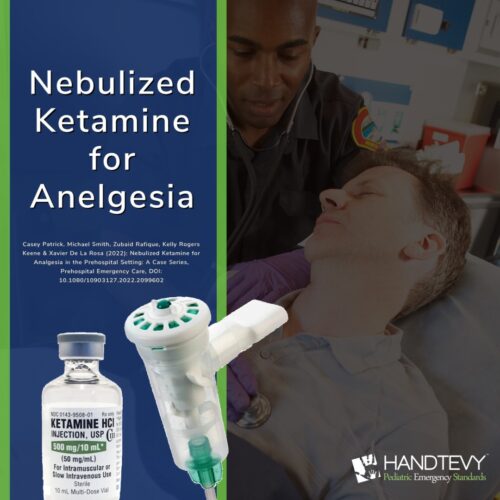Nebulized Ketamine for Analgesia in the Prehospital Setting

IV, IM, and Intranasal Ketamine for analgesia have become common in many EMS systems.
But what about NEBULIZED Ketamine?
A study titled “Nebulized Ketamine for Analgesia in the Prehospital Setting: A Case Series” was published in Prehospital Emergency Care. The study, conducted by Casey Patrick, Michael Smith, Zubaid Rafique, Kelly Rogers Keene, and Xavier De La Rosa, explores the use of nebulized ketamine for pain management in an urban, ground-based emergency medical services (EMS) system.
Background:
Ketamine has been widely used in the prehospital setting for various conditions in both adults and children. Its applications range from sedation for severe agitation to intubation at full dissociative doses. At sub-dissociative doses, ketamine provides analgesia. A key advantage of ketamine is its non-opioid pharmacology, making it a valuable tool in the current opioid crisis in the US. It acts as a noncompetitive N-methyl-D-aspartate and glutamate receptor antagonist, reducing pain by diminishing central sensitization and hyperalgesia.
Methodology:
The study presents a case series of the initial seven patients treated with nebulized ketamine for moderate to severe pain via a breath-actuated nebulizer in the Harris County ESD11 Mobile Healthcare system in Houston, Texas. The patients were treated between March 10-17, 2022.
Discussion:
Quick thinking ED physician Marc Grossman, MD decided to decompress and drain the epidural hematoma with an EZ-IO® drill and 25 mm intraosseous needle under virtual guidance of a pediatric neurosurgeon until definitive care could be obtained.
Key Findings?
- Patient Profiles: The patients ranged in age from 21 to 78, presenting with various complaints such as sickle cell pain, lumbar pain, shoulder trauma, ankle pain from a fall, headache, hip pain from a fall, and abdominal pain.
- Efficacy: Six out of the seven patients experienced significant pain relief during EMS care. The average time from ketamine administration to ED arrival was approximately 23 minutes.
- Dosage: Most patients received the full prepared dose of ketamine (1 mg/kg). The dose was chosen based on ED data showing similar analgesic effects across a range of doses from 0.75 to 1.5 mg/kg.
- Safety: No major side effects were noted in the EMS medical record narratives. There were no clinically relevant vital sign changes, and the Richmond Agitation Sedation Score (RASS) showed no significant changes post-administration.
- ED Outcomes: Emergency Department (ED) diagnoses varied from traumatic to non-traumatic conditions. Two patients required no additional ED pain medication, and both had ED lengths of stay of approximately 2 hours.
Read the Study: http://ow.ly/zmGm50LgRYw
Interested in more: Here’s a short webinar that Dr. Antevy recorded with Dr. Motov on another publication on this topic: https://youtu.be/enpWIWLUe9o

Peter Antevy, MD
Source: Patrick, C., Smith, M., Rafique, Z., Keene, K.R., & De La Rosa, X. (2022). Nebulized Ketamine for Analgesia in the Prehospital Setting: A Case Series. Prehospital Emergency Care.
DISCLAIMER:Pediatric Emergency Standards Inc. does not make clinical or medical decisions. The Handtevy System is intended to be utilized as a guide only. Provider’s experience and training should be the final determinant of clinical treatment decisions.

